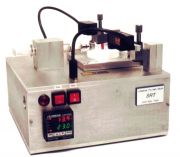Crosslinking Structure
How crosslinked are your polymers?
Using several techniques, our scientists can tell you the degree of crosslinking in your:
- epoxies
- elastomers
- hydrogels
- plastics
Crosslinking influences mechanical properties, swelling behavior, and wear resistance in many materials.
Swell ratio testing is usually conducted on crosslinked materials. In this test, a sample is placed in a good solvent at a particular temperature, and the change in height of the sample is monitored as a function of time. The crosslink density and molecular weight between crosslinks can be calculated from the final swell ratio using details of thermodynamic interaction between the sample and the solvent.
What test methods are appropriate for crosslinking determination?
The following tests will report swell ratio, crosslink density, and other parameters associated with crosslinking.
- ASTM F2214 standard test method for in situ determination of network parameters of crosslinked ultra high molecular weight polyethylene
- ASTM D2765 standard test methods for determination of gel content and swell ratio of crosslinked ethylene plastics
- Dynamic mechanical analysis (DMA) can also be used to differentiate degree of crosslinking in materials.
Density Measurements
Density measurements are sometimes performed along with crosslinking measurements. Density is commonly performed by two techniques at Cambridge Polymer Group.
- ASTM D1505 standard test method for density of plastics by the density-gradient technique
- ASTM D792 standard test method for density and specific gravity (relative density) of plastics by displacement
Contact us to have a discussion with one of our scientists about your project or to request a quote.
